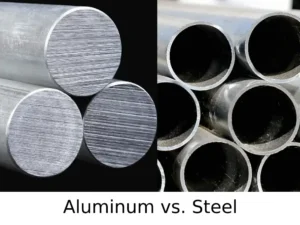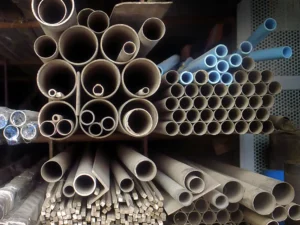
In different industries, people use metals for various applications. Two of these metals are aluminum and steel. Metals can be divided into two groups. These are ferrous and non-ferrous metal groups. Aluminum and steel are two metals that we can use for many different things.
In manufacturing industries, aluminum and steel play a crucial role. They use them to make complex metal parts. They offer exceptional benefits in automotive and aerospace industrial applications.
So, it’s essential to understand which material best suits your needs. Picking the best metal depends on a few things. These include how well it fights rust, how easy it is to shape, and how malleable it is. Also, consider how strong it needs to be. Think about the weather where you are and how much it costs.
In this article, we will discuss the uses of aluminum and steel. Moreover, we will comprehend the differences and characteristics of aluminum and steel.
Aluminum vs Steel – Key differences
Aluminum vs. steel metals are different from each other based on chemistry. Aluminum is a soft metal with a silver-grey color. It has a lustrous, shiny surface. It is lighter and more delicate than steel, with a low melting temperature. It has a low density. Aluminum is non-magnetic and stiff to corrode. This peculiar characteristic of aluminum helps it to withstand harsh environments. So, aluminum is best suited for making plane parts. Aluminum is also a good conductor of heat and electricity.
Steel is a metal alloy. Carbon, iron, and alloying metals come together to form steel. These include chromium, nickel, molybdenum, and silicon. It has high weight and density. Steel is less conductive than aluminum. Moreover, its melting point is higher than that of aluminum. Also, you can weld steel. So this makes it ideal for construction and structural applications.
Let’s discuss the comparison of Aluminum Vs. Steel.
Corrosion Resistance
The ability of metals to resist corrosion plays a significant role in manufacturing. We get aluminum metal from alumina (alumina oxide). Aluminum has an excellent ability to inherit rust. An aluminum oxide layer forms on the aluminum’s surface. This limits its exposure to air and oxygen and prevents further oxidation. That’s why aluminum can withstand in the long run and not rust over time.
When aluminum meets specific salt, it starts to rust. It can rust fast or break if it’s around acids or bases. But we can stop this from happening by doing something called anodizing.
Anodizing means an extra protective layer on the surface of aluminum. It contributes to increased cost factors. Aluminum used in marine applications needs anodizing layers. Common grades used for aluminum in marine applications are 2024, 5052, 6061, 6063, and 7075.
Steel has a multitude of different alloy grades. Stainless steel has a lower corrosion resistance ability than aluminum. It is easily eroded in harsh environments. But Stainless steel has corrosion resistance.
Chromium is pivotal in protecting stainless steel from rust. It can defend steel in harsh environments like acidic conditions. Stainless steel, like grades 304 and 306, thrives in harsh environments. It even braves the salty bite of the ocean. Yet, there’s a risk of corrosion in some steel cases. So, it’s best to protect its surface from paint or coatings. Coating of zinc metal can protect steel from rust due to the galvanizing.
Malleability
Aluminum is the second most flexible and elastic metal in nature. Strong and flexible, it bends into unique shapes without a crack. The high malleability property makes it suitable for metal fabrication applications. Metal prototypes and complex geometries are easy to make by using aluminum metal.
Steel is approximately 3.5 times harder and heavier than aluminum. So, it’s difficult to bend or deform steel under high pressure or heat. Some lighter steel forms, like mild steel, which is softer. However, if we compare mild steel vs. aluminum, aluminum takes the lead due to its elastic strength.

Comparison of Strength
The strength of metals depends on tensile strengths, strength-to-weight ratios, and Young Modulus. Steel gets stiff under high pressure or heat. Steel has a higher strength than aluminum. The strength of steel is due to plenty of carbon. The steel comes in three forms, determined by the varying amounts of carbon it contains:
- Low Carbon
- Medium Carbon
- High Carbon
Aluminum has higher strength-to-weight ratios than steel. The strength-to-weight ratio for aluminum is 1/3 that of steel. It means aluminum can support a similar structure to steel but be less heavy.
Aluminum is lighter than steel. This gives it more advantages in structural, framing, and automotive sectors. Also, it performs well in cold weather applications. It becomes strong with a drop in temperature.
Comparison of Weight
Let’s understand aluminum and steel based on their weight. Being denser than aluminum, steel comes with a weight/density of 2.5 times that of aluminum.
The density of steel is 490 lb/cubic feet. Meanwhile, the density of aluminum is 169lb/cubic feet. Steel is heavier and more complex than aluminum due to its high carbon content.
Aluminum is half of the weight of steel. In the boat-building process, aluminum vessels are super lightweight. It would weigh only one-third as much as the steel boat. However, they’re both rigid enough to handle the waves. T.
Cost
When picking which metal to use for a project, how much it costs is essential. This depends on what it looks like, how it’s made, how big it is, how many you need, and how much care it needs.
Aluminum is a light metal, so buying it in bulk is cheaper than steel. It can be expensive if you don’t believe it in bulk. Mild steel and carbon steel are more affordable than stainless steel. So, stainless steel is more expensive if we compare stainless steel vs. aluminum. In custom extrusion applications, aluminum is best to use.
Aluminum costs more than steel. Aluminum’s average approximate price range is 2500 to 2700 USD per metric ton. The price for steel ranges from 500 to 1500 USD per metric ton. These prices can fluctuate. They depend on market trends, supply and demand, and raw material availability.

Industrial Applications
Steel and aluminum offer a wide range of industrial applications. Both metals offer versatile applications from automotive, aerospace, and structural to consumer electronics. Let’s discuss the diversified applications of each metal in detail;
Construction:
Engineers reach for steel in construction as steel has high tensile and compressive strengths. So, they prefer steel for building buildings, roads, bridges, beams, and grinders.
Aluminum and steel also share some construction uses. Both shine in cladding applications, like roofing and siding.
Automotive:
The automotive industry diverted its focus on aluminum because of high strength-to-weight ratios. Steel has greater strength. Aluminum is a better pick for cars because it makes them lighter. This helps them work better. Aluminum vehicles can save up to 40% of weight compared to steel vehicles.
Aerospace:
Airplanes fly thanks to aluminum! It’s light and robust, so engineers use it to build wings, engine parts, and other essential pieces. But not everything on a plane is aluminum. Landing gear needs to be super tough, so they use steel instead. Steel can handle more weight and heat.
Chemical Industries and Power Plants:
Steel is a major component of various chemical industries and power plants. Steel vessels and heavy-duty turbines are generally made of steel due to its strength.
Energy Sector:
The energy sector uses steel for its strength, corrosion resistance, and reliability. Steel is used in power plants as it supports structures. However, the use of aluminum is in power transmission lines. Aluminum also conducts heat in cooling systems.
Electrical:
- Aluminum’s lightness and flexibility make it easier to shape into wires than copper. You’ll find it in the laptops, smartphones, and even in your toaster!
- Steel steps in for motors, generators, and transformers. Its iron content helps it get along with magnets, making it great for handling electricity.
Packaging and Consumer Goods:
Aluminum wins the packaging game. It’s naturally non-toxic, making it safe for food, medicine, and drinks. It’s all around you – from soda cans to utensils to those shiny fridge shelves!
Conclusion:
Steel and aluminum are a power couple! Steel is the tough guy. It deals with buildings, machines, and cars. Aluminum, the lightweight champ, shines in wires, cans, and even your car. These have unique strengths, making them valuable players in our lives.
These metals provide features that are the basics of almost every manufacturing industry. From aerospace to consumer goods, aluminum and steel cover every aspect.
The choice of metal does not only depend on the cost. Also, keep design geometries and processes in mind. So, which material is best? Both are unique in their perspectives and diverse range of applications.
